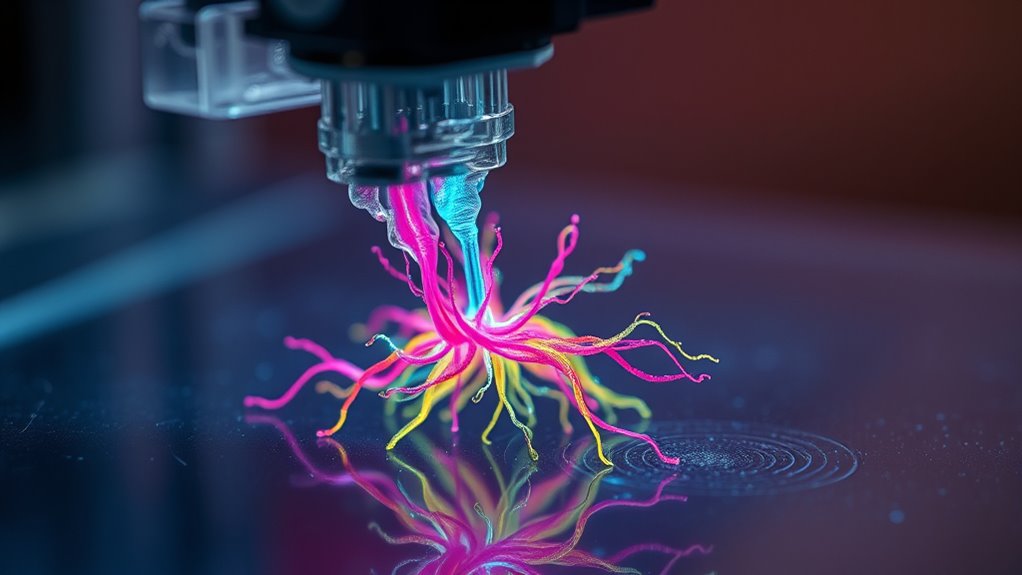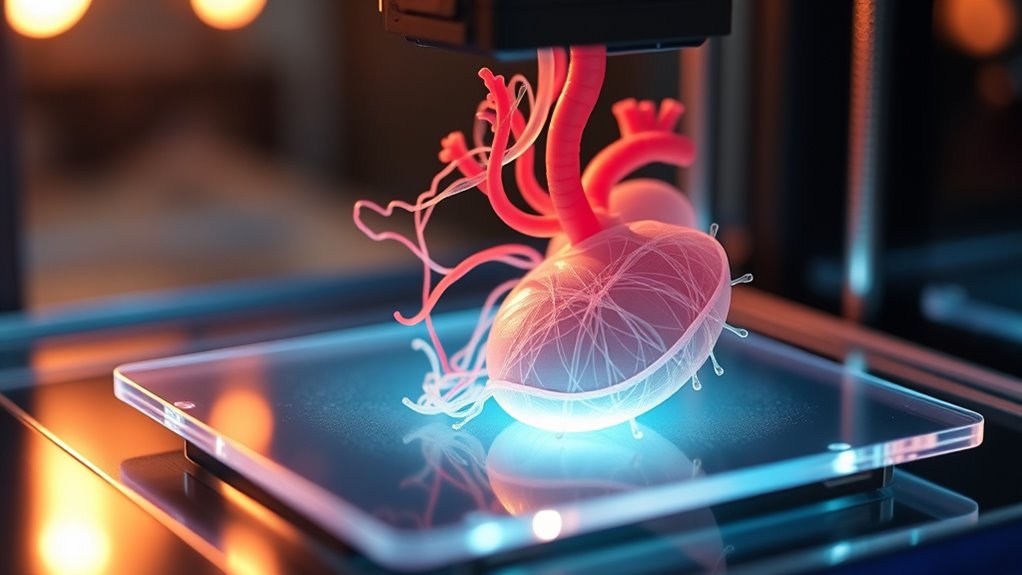Bio-ink printing is advancing quickly toward producing functional, 3D-printed organs. Researchers are developing better bio-inks, focusing on biocompatibility and tissue durability, which make lab-grown organs more feasible for clinical use. Although challenges remain, scientific, ethical, and technological progress signals that organ printing could soon become a reality. If you want to understand how this breakthrough is shaping the future of medicine, there’s much more to explore.
Key Takeaways
- Advances in bio-ink materials and printing technology are bringing 3D-printed organs closer to clinical reality.
- Researchers are successfully creating functional tissues that support cell growth and integration.
- Challenges like ensuring long-term viability and safety are actively being addressed through ongoing research.
- Ethical and regulatory discussions are guiding responsible development of lab-grown organs for transplantation.
- Personalized, organ-specific bio-inks are paving the way for tailored medical treatments in the near future.

Have you ever wondered how scientists are revolutionizing medicine with tiny, living structures? It’s all thanks to bio-ink printing, a groundbreaking technology that’s bringing 3D-printed organs closer to reality. But as impressive as this innovation is, it also raises important questions around ethical considerations and material innovations. You might think of bio-ink as a special kind of ink, but instead of ink made from pigments, it’s composed of living cells and biomaterials. These materials are carefully designed to mimic the natural environment inside your body, allowing scientists to print structures that can potentially replace damaged tissues or organs. The process involves layering these living cells with incredible precision, building complex tissues layer by layer, much like assembling a tiny, biological puzzle. Recent advances in biocompatibility are helping to improve the integration and safety of bio-printed tissues in the human body. Additionally, innovations in cell viability are crucial for ensuring that the printed tissues remain healthy and functional after printing. The push for material innovations drives this field forward. Researchers are constantly developing new bio-inks that are more compatible with human tissues, more durable, and capable of supporting cell growth and function. These materials need to be biocompatible, meaning they won’t cause adverse reactions when implanted. They also have to have the right mechanical properties to withstand bodily functions, whether it’s the flexibility of skin or the strength of bone. Advances in nanotechnology and biomaterials allow scientists to fine-tune these properties, making the printed organs more realistic and functional. As these innovations progress, the potential for printing organs like hearts, kidneys, or livers becomes less distant. Imagine a future where waiting lists shrink because you could receive a custom-printed organ tailored specifically to your body’s needs.
However, this progress isn’t without ethical considerations. As you might expect, creating living tissues and organs raises questions about the morality of producing and potentially implanting lab-grown structures. Who owns these bio-printed organs? Should they be used for experimentation or enhancement beyond therapeutic purposes? There’s also concern about the safety and long-term effects of implanting bio-printed tissues into patients. Ensuring these organs are safe and effective involves rigorous testing and regulation, which can slow down the pace of innovation. Still, many believe that addressing these ethical issues early on will help guide responsible development. As you observe this rapid evolution, it’s clear that bio-ink printing isn’t just a technical feat — it’s a frontier that combines science, ethics, and innovation to reshape the future of medicine.
Frequently Asked Questions
How Long Does It Typically Take to Print a Functioning Organ?
Printing a functioning organ usually takes several hours to days, depending on the organ’s complexity and printing efficiency. You might expect organ development to be faster as technology advances, but currently, it’s a time-consuming process. The detailed printing, cell growth, and maturation stages all impact the timeline. While rapid printing is improving, developing fully functional organs still requires careful precision and patience, making it a gradual but promising progress.
What Are the Main Ethical Concerns Surrounding 3d-Printed Organs?
You might wonder about the main ethical concerns with 3D-printed organs. Informed consent is essential, ensuring patients understand risks and benefits. There’s also the issue of equitable access, so everyone can benefit regardless of socioeconomic status. You should consider how to prevent exploitation or unequal distribution. Addressing these concerns helps promote responsible development and use of this groundbreaking technology, protecting patient rights and societal fairness.
Can Bio-Ink Printing Be Used for Personalized Medicine?
Think of bio-ink printing as a tailor crafting a suit perfectly fitted to you. It enables personalized treatment, offering custom regeneration that matches your unique biology. With this technology, you could receive treatments designed specifically for your body’s needs, improving outcomes and reducing rejection risks. Bio-ink printing turns the dream of individualized medicine into reality, making healing as unique as you are and transforming healthcare into a truly personal experience.
What Are the Current Regulatory Hurdles for Clinical Implementation?
You need to understand that regulatory approval is essential for clinical implementation, and safety standards are a major concern. Currently, agencies like the FDA require extensive testing to ensure bio-ink printed organs are safe and effective. Managing these hurdles means demonstrating consistent quality, addressing biocompatibility, and meeting strict guidelines. Until these regulatory challenges are overcome, integrating bio-ink printing into mainstream medicine remains a complex process.
How Affordable Will 3d-Printed Organs Be for Patients?
You might wonder how affordable 3D-printed organs will be for you. As technology advances, costs are expected to decrease through better cost reduction strategies, making these organs more accessible. Insurance coverage could also expand, helping to offset expenses. While prices may initially be high, ongoing innovations and policy changes aim to make 3D-printed organs a viable and affordable option for many patients in the future.
Conclusion
Just like a master chef crafts a perfect dish, scientists are now shaping life’s future with bio-ink printing. It’s not science fiction—it’s happening now, bringing the dream of 3D-printed organs closer than you might think. Imagine a world where lost organs can be replaced with custom-made, lab-grown versions, saving lives and transforming medicine. The future is unfolding rapidly, and you’re on the brink of witnessing a revolution that could redefine what’s possible for human health.









